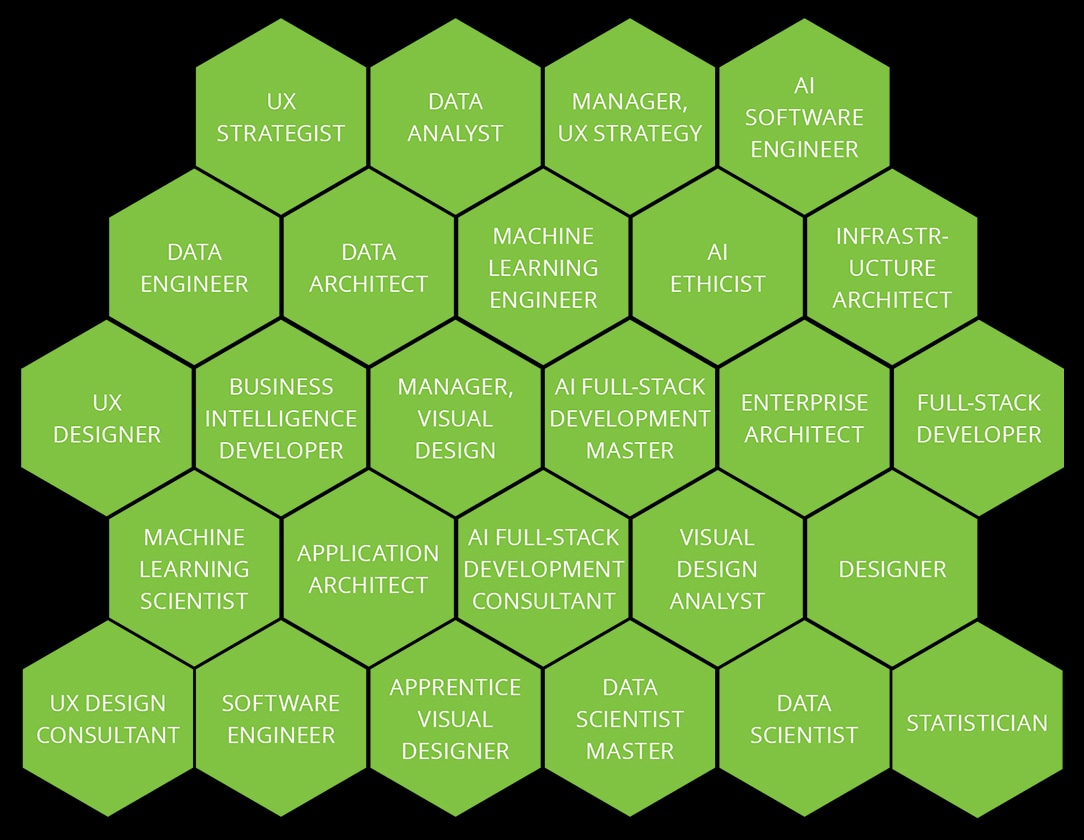Deloitte AI Institute
Building successful AI teams
It’s no small feat in this market
Building diverse teams in tech organizations that succeed
A combination of culture change, job restructuring, hiring, reskilling, and incorporating contract workers will deliver the team needed for a successful AI talent ecosystem. Assembling teams to succeed requires companies to reexamine everything:
1) The teams themselves, including individual job descriptions, tiles, and career paths;
2) Team structures, including organizational design, internal alignment, and the integration of skills and capabilities, particularly with the increasing reliance on outside talent; and
3) Team enablement, including culture, communications, collaboration, continuous learning, reskilling, and upskilling.
However, given the talent shortage—especially among data scientists and other stem professionals—team building is a complex undertaking. For four consecutive years, online employment resource Glassdoor has ranked data scientist the No. 1 us job because it is so highly sought-after. The US Bureau of Labor Statistics reports that the demand for AI skills will drive a 27.9% rise in employment through 2026. What’s needed is a thoughtful approach to building not only the best AI teams, but also the structures they need to work within to be successful.

Beyond the IT department: It’s about building an AI culture
The process must begin with the executives at the top; they must commit to and propagate change company-wide. The lack of an all-encompassing AI culture that truly values data and analytics capabilities and the superior decision-making that flows from the technology is holding back many global businesses in their AI journey.
By combining AI technology with the fields of medicine and science, organizations are looking for opportunities to transform some of their most critical processes and achieve sustainable competitive advantage through AI.

Technology has become everyone’s job
Today every job requires an orientation toward technology. When asked about Amazon’s $700 million reskilling investment for employees, Beth Galetti, Senior Vice President of Worldwide HR acknowledged that the most consistent thing the company sees changing is the need for some level of technical skills in any job. With basic tech-savviness, employees have not only the fundamental skills they need in a quickly evolving and competitive environment, but also the mindset required to support a flourishing data and analytics culture.
In addition to being tech-savvy, AI teams must possess an understanding of the organization’s business because they will be tightly integrated within the business units. The best data scientists aren’t just technically minded; they understand the organization’s business challenges and can assist in problem-solving. It’s no longer enough to know python and cloud technologies; AI teams must also be business-savvy.

Finding the right technology skills
These days, finding the right mix of technology skills for AI teams is challenging. Most companies are looking for individuals with a four-year degree in math, data science, statistics, or computer science to qualify for an entry-level AI position. Master’s and doctorate degrees in computer or cognitive science are becoming increasingly common as well as desired by the companies who are hiring them.
In addition to educational degrees, among the skills and knowledge those working with AI must have are:
- Programming.
- Linear algebra, probability, and statistics.
- Big data technologies.
- Algorithms and frameworks.
- Communication and problem-solving.
Acquiring such skills doesn’t happen overnight. It takes years of training. In a rapidly evolving field, it’s no wonder that the time needed to acquire such skills contributes to the talent shortage.

The high demand for talent means more hiring challenges
Computer occupations are projected to grow 11.5% from now until 2029. That’s about three times as fast as the average occupational growth. The mathematical science work-related sub-group is projected to grow the fastest among all STEM professional groups. However, these occupations,
which include data scientists, mathematicians, and statisticians, are a relatively small portion of the total, representing only 2% of all STEM jobs in 2019. The employment growth for this group, however, is estimated at 26.5% from 2019—2029.
When it comes to data scientists, there was a 250,000-person shortage in 2020, indicating high demand but low supply. And the average data scientist turnover is just two short years, with salaries on the rise.
AI teams must also become more diversified, as they don’t currently reflect the diversity of the global population, causing companies to experience bias within their data. The best way to mitigate it is to build a team with diverse perspectives, including those of women and people with varied ethnicities and backgrounds. So far, few women and minorities have been part of AI and data teams. Hiring and mentoring them should be a top agenda item for companies.
Understand that companies cannot buy their way out of the problem
Because the talent shortage is so intense, data science teams are going to come from several sources. There just isn’t enough top AI talent to hire. Advanced AI teams will need to be a mix of new hires, current employees, business and technical experts, contract workers, and those from diverse backgrounds.
Companies will benefit if they can identify the right capabilities with which to build AI teams versus just the skills around certain technologies or degrees. For example, instead of specific Python experience, start identifying people with solid problem-solving skills and the ability to write code and learn new things quickly.
It’s not only about who but also how AI teams work within an organization that will matter. Advanced AI teams are going to have to be thoughtfully structured, so that the work is attractive and top performers have incentives to stay.

Structuring an Advanced AI team: Finding the best fit
Putting the best data scientists in the right jobs is critical, and structuring the team is like putting together pieces of a puzzle. When it comes to AI, there is no one-size-fits all because every company operates differently and has different use cases and demands. However, AI teams are generally organized according to one of the following structures:
- Centralized in an established center of excellence (COE) that has management and governance oversight.
- Decentralized in teams organized around products, functions or business units that are matched with domain experts.
- Hybrid structure, which is a combination of the two.
Companies should examine what might work best for them. However, regardless of the structure, data science teams should resemble a pod with a variety of skills and experience, such as technical product management, product management, and data-specific AI expertise with an in-depth knowledge of the industry and the business unit. Teams must also be evaluated regularly as roles are continually evolving.
Potential roles within the team

A winning AI team combines existing and new skills
Hiring to train.
For new hires, backgrounds in math, statistics, and hard science are helpful, but so is experience in business. STEM applicants can take the business fundamentals they’ve learned and apply them to new technology. Applicants with business backgrounds can be trained in the technology.
Reskilling and upskilling existing workers.
The first step is to identify workers who may want to take on a new challenge and focus on their capabilities instead of their existing skills. Training programs from internal and external sources can build on the skills they have. Organizations may want to encourage additional
degrees and subsidize them.
Retention: If projects aren’t interesting, it could be a major obstacle.
There are several options organizations can employ to incent team members to stay. These include:
- Mentoring and coaching opportunities.
- Offering a diversity of projects to encourage experimentation and the prospect of working with new technologies.
- Creating continuous learning activities through things like hackathons and collaborations with AI experts.
- Developing relevant job descriptions that can lead to flexible roles and careers within the organization.
- Ensuring job titles match the work team members are doing.
- Providing clear career destinations with clear upward mobility and compensation that’s competitive.
Successful AI team-building strategies
When structuring AI teams, it’s important to consider short-term and long-term options. Short-term solutions may include shared or managed services from an external partner that has AI teams already in place.
In addition, companies considering a merger or acquisition should keep in mind that AI talent can be absorbed in the process and companies should work toward onboarding them.
The bottom line: Upskilling is not easy. It’s important to have employees in place who are already experienced in designing programs to help team members achieve their goals in a timely manner. Advanced AI teams need strong leaders whether you source them internally or externally to run an AI effort.
For the longer term, organizations need to think about broader talent development for advanced AI teams. This initiative should include nurturing women trailblazers within the organization to serve as AI role models.

Despite the shortage of skilled AI talent, there are several ways to build, train and retain effective teams that will do their best work with machines. These teams can be most powerful when they can bring human and technological capabilities together to rearchitect work and deliver new value to all stakeholders. Given the right environment, skilled AI teams can unlock an organization’s potential to achieve greater results than either humans or machines could achieve alone.
Hiring managers cannot expect to find an abundance of people with 20 years’ experience in machine learning. The technologies are too new. A combination of new-hire STEM skills with experienced technology workers is needed.

Get in touch

